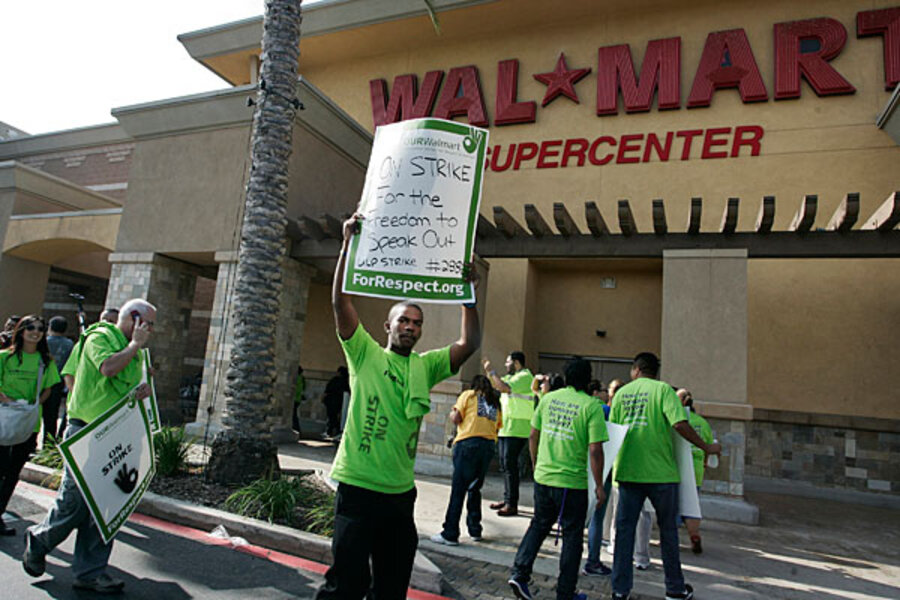Wal-Mart Black Friday walkout: How bad will it be?
Loading...
| Los Angeles
A long-simmering feud between Wal-Mart and some of its disgruntled employees appears set to climax on Black Friday as a coordinated employee walkout.
How much will it impact the nation’s biggest retailer on the nation's biggest shopping day?
Employee groups backed by labor union organizers say the disruptions will be significant, potentially leaving stores in the hands of replacement workers who don't know where items are or how to use the cash register.
Wal-Mart counters that the disaffected workers make up only a tiny fraction of its workforce, meaning any disruptions will be virtually unnoticeable.
The reality is hard to pin down. One October attempt to organize a walkout spread to 12 states, but involved only 100 workers – out of a nationwide workforce of 1.4 million employees. But organizers say the Black Friday events will be beyond anything they have attempted so far.
Workers in blue states like California might meet with more success than those in other areas.
For instance, Daniel Hindman, who has worked at the Paramount, Calif., Wal-Mart since 2008, says he will walk out Friday with 100 of the store’s roughly 130 associates, accompanied by at least five of the store’s 20 or so managers.
“Wal-Mart may try to bring in other workers at the last minute,” says Mr. Hindman. But those people will not know the stock “or even how to ring up items at a cash register,” he says.
Janna Pea, a spokeswoman for one of the workers' groups, adds that she expects some 1,000 of the roughly 4,000 chain stores to be hit with walkouts Friday.
Wal-Mart dismisses such claims. There are only a “handful of associates, at a handful of stores scattered across the country that are participating in these ... made-for-TV events,” says spokesman Kory Lundberg in an e-mail.
At issue are wages, benefits and working conditions. Wal-Mart employees are not unionized and cannot collectively bargain, so employee groups such as OUR Walmart and Making Change at Walmart have agitated as a way to push for a living wage ($13 an hour) and affordable healthcare for full-time employees, among other changes. They are backed by the United Food and Commercial Workers International Union (UFCW).
Wal-Mart sees the effort as a proxy attempt by the UFCW to stir up workers and drive them to unionize. Many of the "workers" at the events “aren't even Walmart workers” but union representatives and other union members, says Mr. Lundberg
The company has filed a complaint with the National Labor Relations Board in the firm’s home state of Arkansas, alleging that the UFCW is unlawfully interfering in its affairs. It is hoping for legal relief in time for the holiday.
Some legal experts doubt that will help.
“The bottom line here is that labor would not be talking about this strike on Black Friday if they were not well aware that there are ways to pull it off without violating the law,” says Jack Merinar, a labor attorney with Steptoe & Johnson in Bridgeport, W.V., via e-mail. Even if a violation is proven, he notes, relief will come too late. “Labor holds the upper hand here so long as they are able to persuade a sufficient number of employees to participate to make the impact felt.”
The answer to that might not be known until Friday, but labor is smart to move on this holiday.
"This is the day when an issue will get maximum attention,” says Steven Kropp, a visiting professor of law at Stetson University in South Gulfport, Fla.
Merely the threat of more shopping chaos on a day already defined by it could drive away some customers, he adds. “Consumers simply may not wish to shop where there is all this activity going on that doesn’t relate to the shopping itself.”
Wal-Mart would do well to dispel those concerns, says Michael Robinson, executive vice president of Levick Strategic Communications.
“They presumably have a vast database of information about their customers,” he says. “Now is the time to communicate directly with them via social media and e-mail, letting them know that everything they want or need will be ready for them on Friday.”







